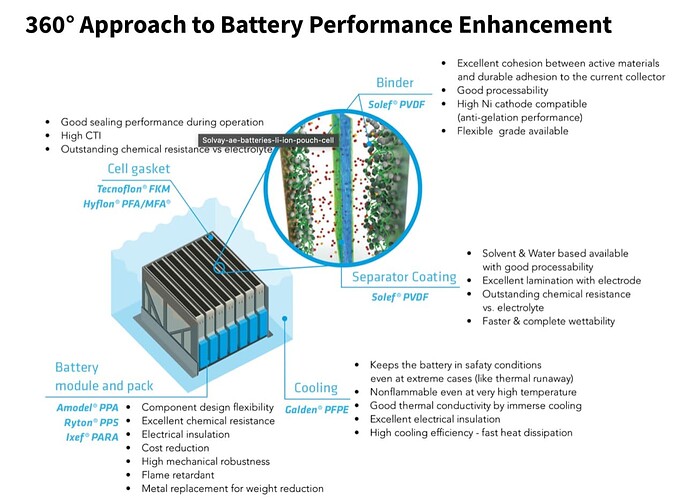In this post, let me talk about FP (particularly PVDF) application in EV batteries and few technical things.
Arkema PVDF Binder Page →
Very first thing is that PVDF is used in the EV battery electrode (PVDF binder) and also in separator coatings. GFL IESA presentation talks about only binder part and not coating part. Most likely, GFL would also have separator coating as well - but better to get this clarified from management.
Solvay PVDF Binder Page →
https://www.solvay.com/en/chemical-categories/specialty-polymers/batteries/li-ion-battery-cells
Solvay Li-Ion Pouch Cell Page →
https://www.solvay.com/en/chemical-categories/specialty-polymers/batteries/li-ion-pouch-cell
Solvay Video →
Above image illustrates application of various FPs in EV batteries
- PVDF binder for electrodes and separator coatings (Solvay brand is Solef)
- Cell gasket is another application - which uses FKM, PFA (GFL has both of these products)
- Completely new thing for me is battery cooling application where PFPE is used - upcoming area, we can ask this to management
Arkema PVDF binder technical sheet → kynar-pvdf-battery-brochure (1).pdf (1.7 MB)
This (page 4/5 in particular of Kynar brochure) along with Solvay page lists 2/3 important properties needed in PVDF binder product. Let me bring them out →
Arkema →
Solvay →
Key Properties Needed
- Lower binder loading - This simply means that less and less binder should be needed in EV battery, kind of obvious requirement.
-
High Adhesion - This simply means that more active material (read electrolyte) should be absorbed/allowed through electrode.
Solvay talks about homogenous dispersion of active material and conductive carbon and stable bonding with metallic collector.
High adhesion means lower resistance = higher current = higher efficiency - Low Swelling - This means that swelling of electrode should be less otherwise volume expansion would cause mechanical stress and batteries could crack.
PVDF (or any fluorine polymer for that matter) is used due to its inertness in chemical reactions. But high adhesion of electrode is slightly contra requirement to this inertness.
In summary, making commercial grade PVDF binder is no joke with all these strict requirements. PVDF binder is also critical in shelf life and efficiency of EV batteries. PVDF binder looks harder than PVDF films for solar because only inertness property is enough for film product, binder has more requirement. If GFL can scale up PVDF binder, it would be an validation of technical prowess of the company and validation of high quality business model.
Tesla Battery Electrode Coatings
This is an interesting video from Tesla in electrode innovation. Currently graphite is used in anode for EV batteries. Tesla is looking to use silicon instead of graphite as silicon absorbs 9x more Li+ molecules (read better efficiency for battery) but it has an inherent limitation that silicon expands in battery and this volume expansion can cause mechanical stress in battery.
The innovation to get around this volume expansion of silicon is to have polymer binding coating. It is not disclosed what this binder is and whether it is one of the FP.
Will write another post on PVDF solvents and few more technical things.





